10 trends in the data analytics tools of the future
Data analytics platforms will bring the concept of Dashboard as a commodity to companies of any size.
In the future, Business Intelligence and Data Analytics tools will be indispensable in any company to be able to manage and make decisions in an increasingly hyper-connected world with huge amounts of data to analyze.
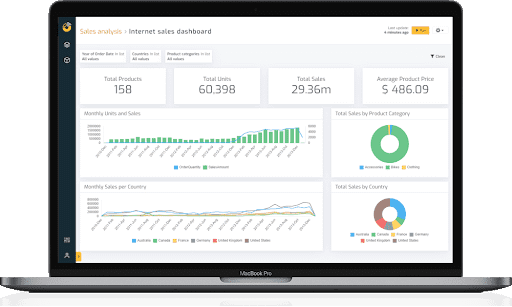
From the Biuwer team, the first Business Analytics platform developed entirely in Spain, we contribute our vision of what the Data Analytics platforms of the future will be like and therefore, in this article we delve into the 10 characteristics or trends that these types of platforms will have.
1 - Easy to use
Currently we are faced with the problem that Business Intelligence platforms are hard to manage or administer. In fact, when a company enters the implementation of a project of this type, it is not surprising to see exclusive tasks for the configuration of the data visualization platform in the calendar.
Tools in the future should be easy to use and easy to configure. The trend should be to facilitate non-technical user profiles to manage their company's data, thus avoiding the complexities that we can find today in some tools.
At Biuwer we have always designed our platform with this objective in mind, aware that these types of tools are difficult to configure, we try to anticipate this trend, although we are aware that we can always improve.
One of the characteristics that in recent years has helped this trend has been the capacity for “self service analytics”, which amounts to doing it yourself in the world of analytics. This functionality will help to make these types of tools easier to use and more accessible, but it must be accompanied by clear documentation and a very friendly user interface.
2 - 100% cloud platforms
At present, we are all aware that working in the cloud is a fact, but there are still companies that are reluctant to use 100% cloud platforms both for decision-making and for other critical aspects of the company such as systems management tools, ERPs and other similar applications.
This mistrust will disappear over time as the platforms deployed in the cloud will become more and more secure, implementing communications and information encryption mechanisms and ultimately making these platforms increasingly reliable.
Other aspects to consider is having high availability and ease of access. By this I mean that a cloud platform will make it easier for us to make our data visualization and decision-making tool accessible 24 hours a day and we do not have to spend time and resources maintaining our own system, which translates into direct cost saving.
Another feature that a cloud data platform gives us is that we will say goodbye to desktop tools. Many platforms in the industry currently have desktop tools to design dashboards or data visualizations, or desktop applications to share or view a previously designed dashboard.
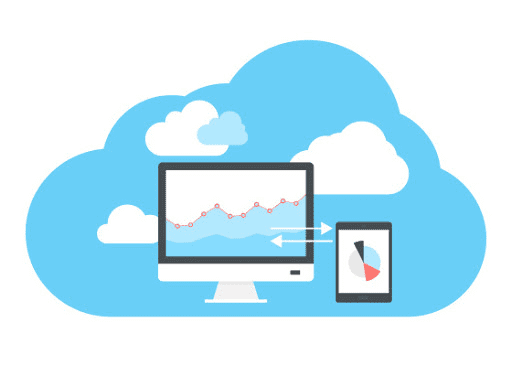
With a 100% cloud platform we will avoid incompatibilities at the application level. What happens if part of your team works with Linux systems or another part with Windows and your tool is not compatible with some of these? Or even what if you share a data visualization to open in a desktop app and you need to update that dashboard? Here we may be including one of the basic rules in business data management known as the single version of the truth.
For this and many other reasons, we have conceived Biuwer as a 100% cloud platform from the beginning. At Biuwer we do not have desktop applications so everything is developed, designed and viewed in the cloud.
3 - Security
Security is an essential aspect in any computer platform and it’s even more so in decision-making systems since we can deal with very sensitive data and information.
Current Business Analytics platforms already have security mechanisms, but this feature must always be present and in the future all available mechanisms that current and future technology allow us should be reinforced. This aspect is key since security is one of the most important factors to generate trust in users.

At Biuwer we highlight some security measures that we already include in all our plans, such as secure access, encryption of communications, user-level access control, user groups, role-based security system, data query engine with encrypted connectivity , data policy system that allows filtering data at a physical level, etc.
In addition to the aforementioned features, we continue to incorporate some features into our roadmap such as two-step authentication or including security mechanisms through BlockChain.
4 - Mobile Analytics
In the future we must be able to make decisions anywhere and at any time, so mobility will be key in these types of tools. Our Data Analytics platform of the future must give us access from any device, be it a mobile phone, tablet, Smart TV, computer or any other display device.
A 100% cloud platform facilitates this since access is done through a web browser, so any device that has a browser will have this feature on its own. It is necessary that the user interface has responsive designs so that it can be adapted to any size.
In addition, it is recommended to have a native application that allows us at least to access the data visualizations.
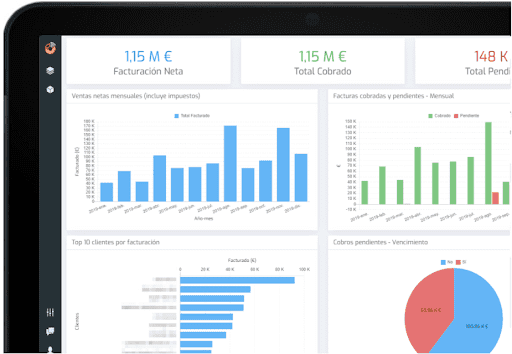
Another of the functionalities that facilitate mobile analytics is the use of what is known as embedded analytics since it allows integrating data visualizations in any type of device.
5 - Hyper Connected platforms
We live in a hyper-connected world, in which every day we have more applications and devices that try to make our work easier, but at the same time, the amount of data that is generated does not stop growing.
This data, whether it is application metadata or valuable data, we must be able to analyze it in a Business Intelligence platform as it can provide us with great value and we can also make decisions if we analyze it together with other data sources.
The Data Analytics tools of the future must be able to connect with a large number of data sources and this will be one of the factors to take into account when selecting one platform or another.
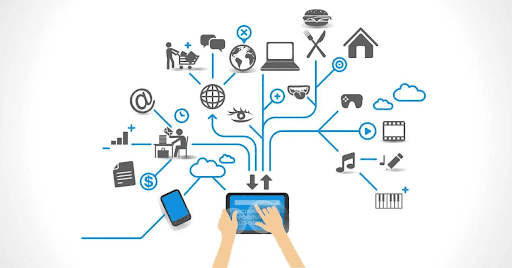
If we have a data integration platform to carry out ETL or data preparation processes, and if it is also integrated with the visualization platform, we can design workflows in which we add all the data sources and design visualizations very quickly.
Some examples of data sources that we may want to analyze:
- Databases
- Social networks
- Cloud applications
- APIs
- Sensors
- Industrial systems
- IoT devices
- Etc
6 - Actionable Data
We will be able to make decisions based on actionable data. Actionable data is generated through actions executed based on conditions that occur in the data.
For example, we can receive an alert, notification or communication by email when a certain condition is met. Let's imagine that we can add a condition to a certain indicator, for example the stock of a product. And that this action is launched when the stock falls below 1000 units. Our Business Analytics system will trigger an alert and warn that this amount has been reached.
This is an example of action but there are many other examples:
- Data-driven alerts / notifications
- Email communications
- Launch actions in external services
- API calls
- Etc

7 - Predictive Analytics
Incorporating predictive analytics capabilities into our visualizations will make it easier for us to anticipate certain scenarios.
The way we understand predictive analytics in Biuwer starts from the phase prior to data visualization, in the data preparation or integration phase, which is the phase in which ETL / ELT processes are normally executed within a flow ingestion data analysis.
It is in this process that we can add learning models through Machine Learning to the data sets that we extract from data sources. As a result we obtain extended data sets with the prediction information.
Once this is achieved, we can incorporate these data sets into the data visualizations in such a way that we can quickly differentiate which data corresponds to the prediction and which to the actual or historical data.
An example of this can be seen in the following chart in which we see the real data in blue and the prediction data in green. In this way we can make decisions based on this prediction.
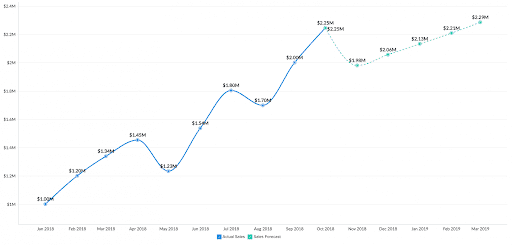
Over time, learning models and Machine Learning techniques will advance in such a way that the confidence we have in these predictions will be greater and greater, so the problem will no longer be in the capacity of the platform itself if not in the model applied to each data set.
8 - Real Time Analytics
Real-time analytics will be one of the great advances in the world of data analytics tools.
Currently there are solutions that allow you to analyze data in real time, but they are usually applications that focus on a vertical itself, with pre-configured panels and visualizations, making this type of analysis easier.
An example of this are trading monitoring tools or log analytics platforms, among many others.
The difficulty of being able to have a real time Business Intelligence system starts from the data collection phase in which the new data has to be processed in real time, storing this data through streaming communication and having the ability to this new data is served and synchronized in our visualization tool.

This is quite a challenge since all stages of the data life cycle are involved, from its generation, processing, storage and finally visualization. So it is not only having the ability to synchronize a dashboard so that new data is loaded, but it goes much further.
9 - Collaborative analytics
Another feature that this type of tool should have is collaborative analytics in which we can highlight the following points:
- Being able to share content and data visualizations with other users or groups, privately or publicly. An example of this we have when we embed a chart or a dashboard in another application or website, or also when we send the link to a person with whom we want to share.
- Interactive documents in the form of Notebooks. Notebooks are documents that are nourished on the one hand by static content and on the other by dynamic content through the data that we configure and connect through our analytics tool. You can share a notebook with others through a link, HTML document or print as if it were a report.
- Have a notification center where we receive alerts, messages from other users, actionable data, etc.
- Being able to annotate the data visualizations in such a way that when I revisit a certain visualization myself or another user we can see what happened at that moment.
- Etc.
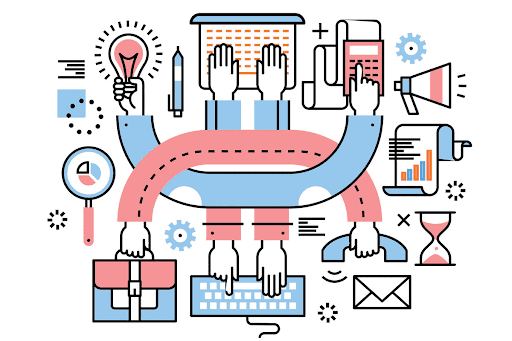
10 - Data preparation - Data integration
And last but not least, having data preparation tools within your data analytics platform will allow you to have all your business data management strategy in one place.
Through a data processing or preparation tool we can define workflows or pipelines that process the data. Thus connecting the data sources, going through intermediate processes of validation, cleaning, calculation, etc. to later be able to store the results of these intermediate processes in a Data Warehouse deployed in the cloud.

One of the great advantages will be to be able to have data warehouses in the cloud, thus obtaining all the benefits that the cloud world has in storing business data.
Our vision at Biuwer
Our vision regarding Biuwer is to gradually incorporate all these trends and add or reinforce those areas that we consider have the greatest benefit for our clients.
In this way, our development roadmap is focused both on the needs of our clients and on future trends, so our commitment will always be to incorporate new technologies to facilitate the decision-making process.
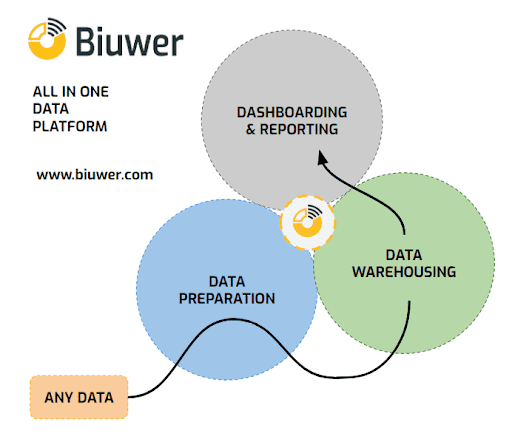
Our vision for the future is to create a single data management and analytics platform in order to have data preparation and processing, data storage and visualization capabilities, all in the same cloud platform.